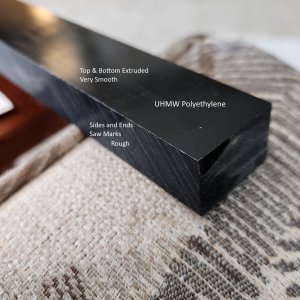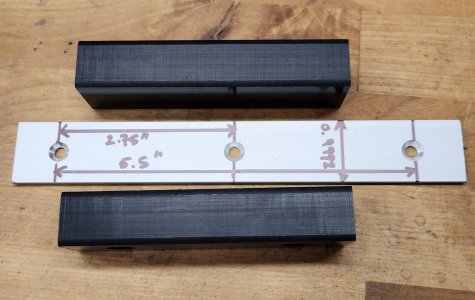I'm working with UHMW polyethylene "bar stock" that's 3/4" tall, 1" wide, in this case 12" long. My understanding is black UHMW is reclaimed (recycled?) product, whereas white UHMW is virgin. This material has a very low coefficient of friction which is a property I need for my project; it's slippery as all get out.
These particular black bars from McMaster-Carr are manufactured using an extrusion process, the white stuff is skived. The problem with the black bars is they are very flat and smooth on the top and bottom which is exactly what I want but, the bars as-sold are really made by sawing a sheet into bars; the sides have obvious saw marks and, while still slippery, are uneven, and not desirable. What I need in this application is for at least two adjacent sides to be extruded-smooth. The white stuff that's skived is very smooth but far, far from flat.

Here's what I've tried so far with mixed success: Since dimensionally, the bars are slightly oversized (1.05" or so), I fixed a 1" aluminum straight edge to the smooth top, centered, and ran the pieces past a ball-bearing Freud router bit, 1" tall, 1/4" shank, installed in a finish router that's table mounted. The aluminum edge acts as a bearing guide. The result is an improvement over the saw-marked finish, but I'd like it to be smoother. The main problem I see with this method is no matter what I do, there's chatter. A secondary issue is the removed material must be electrically charged; it clings to everything, including the surface being milled.
At this point, I'm thinking I may try breaking out my larger router, Hitachi with a 1/2" collet, to see if a stiffer 1/2" shank bit may do better in the chatter department. I'd have to whip up a table mount for it.
It seems to me a plane of some sort may also do a good job, the last one of those I touched was in high school carpentry class. If a plane does give a nice, smooth finish, it can't be at the expense of squareness.
So, figured I'd ask here is anyone has worked with this, or similar material, or maybe has an idea for another approach?
Thanks.
These particular black bars from McMaster-Carr are manufactured using an extrusion process, the white stuff is skived. The problem with the black bars is they are very flat and smooth on the top and bottom which is exactly what I want but, the bars as-sold are really made by sawing a sheet into bars; the sides have obvious saw marks and, while still slippery, are uneven, and not desirable. What I need in this application is for at least two adjacent sides to be extruded-smooth. The white stuff that's skived is very smooth but far, far from flat.

Here's what I've tried so far with mixed success: Since dimensionally, the bars are slightly oversized (1.05" or so), I fixed a 1" aluminum straight edge to the smooth top, centered, and ran the pieces past a ball-bearing Freud router bit, 1" tall, 1/4" shank, installed in a finish router that's table mounted. The aluminum edge acts as a bearing guide. The result is an improvement over the saw-marked finish, but I'd like it to be smoother. The main problem I see with this method is no matter what I do, there's chatter. A secondary issue is the removed material must be electrically charged; it clings to everything, including the surface being milled.
At this point, I'm thinking I may try breaking out my larger router, Hitachi with a 1/2" collet, to see if a stiffer 1/2" shank bit may do better in the chatter department. I'd have to whip up a table mount for it.
It seems to me a plane of some sort may also do a good job, the last one of those I touched was in high school carpentry class. If a plane does give a nice, smooth finish, it can't be at the expense of squareness.
So, figured I'd ask here is anyone has worked with this, or similar material, or maybe has an idea for another approach?
Thanks.

